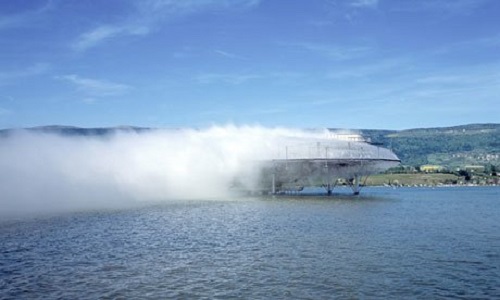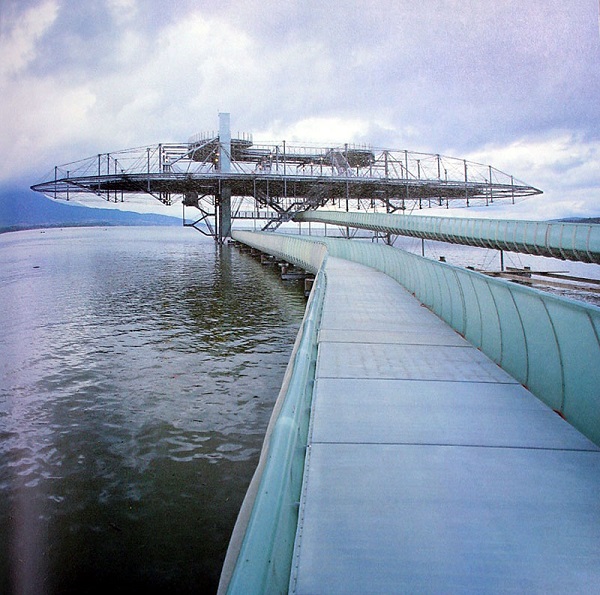Main author
Michael BrooksBlur Building
See the Unusual building of the week series here.
The Blur Building was a temporary pavilion built for the Swiss EXPO 2002 by the architects Diller Scofidio + Renfro (DS+R). Located at the base of Lake Neuchatel in Yverdon-les-Bains, Switzerland, the structure was intended to be an ‘architecture of atmosphere’.
It claimed to use water as the primary building material; pumping it from the lake before filtering and shooting it as a fine mist through 31,500 high-pressure mist nozzles. Controlled by a smart weather system that regulated the water pressure, the water vapour created an ‘artificial cloud’ that dominated its form.
The lightweight structure measured 300 ft x 200 ft, and appeared to hover 75 ft above the lake’s surface on four columns. The columns sat on piles sunk deep beneath the water. A system of rectilinear struts and diagonal rods cantilevered the structure out over the lake, with walkways weaving through it and providing a counterweight. The architects based this ‘tensegrity’ structural form on the work of Buckminster Fuller.
A 400 ft long ramp took visitors to the open-air platform where they were able to enter and move around in the fog, the intention being to experience a ‘white-out’ and alter perception of the senses.
Despite critical success and being visited by more than 1 million people, the structure was not intended to be permanent and was dismantled at the end of the exhibition.
[edit] Find out more
[edit] Related articles on Designing Buildings Wiki
Featured articles and news
The UK's Modern Industrial Strategy: A 10 year plan
Previous consultation criticism, current key elements and general support with some persisting reservations.
Building Safety Regulator reforms
New roles, new staff and a new fast track service pave the way for a single construction regulator.
Architectural Technologist CPDs and Communications
CIAT CPD… and how you can do it!
Cooling centres and cool spaces
Managing extreme heat in cities by directing the public to places for heat stress relief and water sources.
Winter gardens: A brief history and warm variations
Extending the season with glass in different forms and terms.
Restoring Great Yarmouth's Winter Gardens
Transforming one of the least sustainable constructions imaginable.
Construction Skills Mission Board launch sector drive
Newly formed government and industry collaboration set strategy for recruiting an additional 100,000 construction workers a year.
New Architects Code comes into effect in September 2025
ARB Architects Code of Conduct and Practice available with ongoing consultation regarding guidance.
Welsh Skills Body (Medr) launches ambitious plan
The new skills body brings together funding and regulation of tertiary education and research for the devolved nation.
Paul Gandy FCIOB announced as next CIOB President
Former Tilbury Douglas CEO takes helm.
UK Infrastructure: A 10 Year Strategy. In brief with reactions
With the National Infrastructure and Service Transformation Authority (NISTA).
Ebenezer Howard: inventor of the garden city. Book review.
The Grenfell Tower fire, eight years on
A time to pause and reflect as Dubai tower block fire reported just before anniversary.
Airtightness Topic Guide BSRIA TG 27/2025
Explaining the basics of airtightness, what it is, why it's important, when it's required and how it's carried out.
Construction contract awards hit lowest point of 2025
Plummeting for second consecutive month, intensifying concerns for housing and infrastructure goals.
Understanding Mental Health in the Built Environment 2025
Examining the state of mental health in construction, shedding light on levels of stress, anxiety and depression.
























